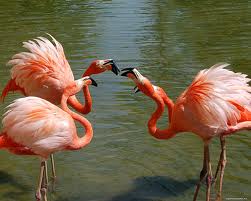 Flamingo - a detachment of birds often included in the squad as a family of Ciconiiformes. In Africa, raspostraneno two types: ordinary, or large (in Algeria and Kenya) and small (in the south-east of the continent - Kenya, Tanzania, Madagascar).
Flamingo - a detachment of birds often included in the squad as a family of Ciconiiformes. In Africa, raspostraneno two types: ordinary, or large (in Algeria and Kenya) and small (in the south-east of the continent - Kenya, Tanzania, Madagascar).Inhabit the shallow salty lakes and lagoons. Breeding colonies numbering half a century ago in some lakes reached a million birds.
 FLAMINGO LIGHT is the smallest of all modern species of flamingos. This species is unique in the way of African flamingos (Phoeniconaias). The total length of its body 80 cm color of plumage usually bright pink. He still has the upper mandible narrower than that referred to his fellows, but it has a beak down into the depth of the keel. The food is predominantly small flamingos snne-green algae and dnatomovye, so the "strainer" he developed more. It is estimated that out of the waters of Lake Nakuru (East Africa) with a 0.4 hectares per year, small flamingos removed about 2,000 tons of blue-green algae. Searching for food, the bird usually drops to the bottom of the beak, and leads them from side to side on the water surface. It breeds in eastern Equatorial Africa - on salt lakes of Kenya, Tanzania to the south and a few, as well as in Asia off the coast of the Persian Gulf and on the lake in Central Sambhor Rajasthan (India). It is believed that the alkaline lakes of Ethiopia, Kenya, Tanzania, there are about 3 million small and red flamingos, but mostly small specimens of flamingos. English ornithologist, Leslie Brown in 1954 found a small mass nesting of flamingos in one of the alkaline waters of East Africa - at Lake Natron. "Here, in these fetid places, in scorching heat and blinding sun - L. Brown writes - Flamingos raise their chicks. . . Although the surface of the sludge is heated very strongly, at the top of the turret nest-temperature does not exceed the normal body temperature.
FLAMINGO LIGHT is the smallest of all modern species of flamingos. This species is unique in the way of African flamingos (Phoeniconaias). The total length of its body 80 cm color of plumage usually bright pink. He still has the upper mandible narrower than that referred to his fellows, but it has a beak down into the depth of the keel. The food is predominantly small flamingos snne-green algae and dnatomovye, so the "strainer" he developed more. It is estimated that out of the waters of Lake Nakuru (East Africa) with a 0.4 hectares per year, small flamingos removed about 2,000 tons of blue-green algae. Searching for food, the bird usually drops to the bottom of the beak, and leads them from side to side on the water surface. It breeds in eastern Equatorial Africa - on salt lakes of Kenya, Tanzania to the south and a few, as well as in Asia off the coast of the Persian Gulf and on the lake in Central Sambhor Rajasthan (India). It is believed that the alkaline lakes of Ethiopia, Kenya, Tanzania, there are about 3 million small and red flamingos, but mostly small specimens of flamingos. English ornithologist, Leslie Brown in 1954 found a small mass nesting of flamingos in one of the alkaline waters of East Africa - at Lake Natron. "Here, in these fetid places, in scorching heat and blinding sun - L. Brown writes - Flamingos raise their chicks. . . Although the surface of the sludge is heated very strongly, at the top of the turret nest-temperature does not exceed the normal body temperature.Hatched, the young flamingos spends the first few days of his life in this relatively cool elevation, and in case of danger is always returned to the nest. On average, this population displays a year 130,000 babies. . . Based on data from annual growth of population, average life expectancy of a flamingo is more than twenty years, which unusually for birds. "
No comments:
Post a Comment